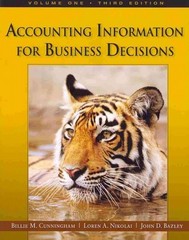Question
John Smith is 55 years old, married to Kim (age 50 years), and they have two children, Susan (age 19) and David (age 15). Susan
John Smith is 55 years old, married to Kim (age 50 years), and they have two children, Susan (age 19) and David (age 15). Susan is a full-time student, taking post-secondary level courses at a university in Canada, and David is in high school. Kim is a lawyer working for a law firm; her net income in the current year is $98,000.
John is also a lawyer but he is self-employed, with his own law practice. John's net business income from his practice (a sole proprietorship) for the current year was $86,000.
John is also a partner in a restaurant business, which incurred a total net business loss of $18,000 in the current year; as a partner in this business, John's share of this loss is $6,000. The restaurant business also incurred a large business loss in the previous taxation year, which John was not able to fully utilize on his prior year's tax return; hence, John has a non-capital loss carryover balance of $2,000.
John also received foreign business income from Legal Widgets Ltd (an American corporation) in the amount of US $1,000 (Canadian dollars = $1,188) before tax, from which U.S. income tax of US $117 (Canadian dollars = $139) has been deducted.
John owns various investments. In the current year, he received interest income of $1,800 from TD Bank (a Canadian bank) and a dividend of $1,500 (actual amount of the dividend) from Canco Ltd., a Canadian public corporation subject to high corporate tax rates.
In November of the current year, John disposed of various shares and marketable securities, which resulted in a taxable capital gain of $8,000, and he disposed of land for a capital loss of $10,000. John has a net (allowable) capital loss carry forward (realized five years ago) of $4,000, which John would like to use as soon as possible.
John provides you with the following other information:
His daughter, Susan, was enrolled as a full-time student taking post-secondary level courses at a university in Canada for eight months of the current year. John paid Susan's university tuition fees of $6,500. Susan's net income in the current year was $3,000. Susan would like to make the maximum transfer available (for tuition, education, and textbook amounts) to her father.
John always makes a donation to the United Way, a registered charity, during its annual campaign. In the current year, he made a donation of $1,500 to United Way.
John incurred the following medical expenses during the current year:
Expenses
Amount
Orthodontic work for David (braces removed)
$5,475
New prescription eye glasses for Susan
1,250
Prescription medication for Kim
237.50
Prescription medication for John
392.50
Private health care premiums
1,500
Part A: In an Excel template provided, calculate the client's minimum Division B (net) income for tax purposes in accordance with the format of Section 3 of the Income Tax Act for the 2019 taxation year. Show all your calculations.
Part B: Calculate your client's taxable income.
Part C: Calculate your client's federal taxes owing or refundable for 2019.
Part D: When finished, upload your Excel workbook into Case Study III in D2L. Obtain solution from the instructor. Grade your answer and explain why you made the errors. Was it a calculation error, misunderstanding of the concept, etc.? Upload graded Excel work with your reflection into Case Study III in D2L to receive reflection marks.
Step by Step Solution
There are 3 Steps involved in it
Step: 1

Get Instant Access to Expert-Tailored Solutions
See step-by-step solutions with expert insights and AI powered tools for academic success
Step: 2

Step: 3

Ace Your Homework with AI
Get the answers you need in no time with our AI-driven, step-by-step assistance
Get Started


